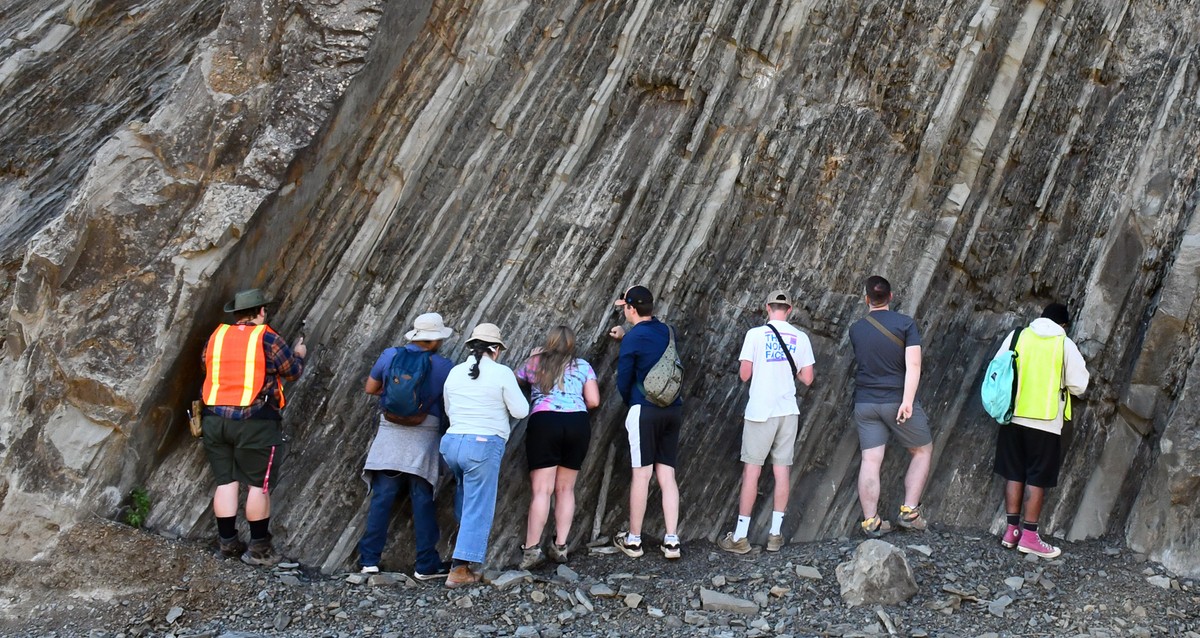— California dreamin ' —
UC geosciences students explore Golden State’s volcanic history
During a walk among towering California redwoods, University of Cincinnati students Kevin Kruse and Cody Kessler stopped to admire a millennium-old stump.
Kruse began counting the tree’s thousand-plus rings with exaggerated deliberation: “One… two… three…”
“I already made that joke!” Kessler said.
Passing them on the trail, Associate Professor Dylan Ward quipped: “It’s less than a million years old. Who cares?”
Geology jokes are to be expected on a geosciences field trip. And a good sense of humor is helpful when students from a Midwestern Research-1 university travel 3,000 miles together to learn about ancient Earth history by seeing it up close.
Students from UC teamed up with a group from California State University, San Bernardino on a whirlwind geologic tour of northern California: from the Marin Headlands at the foot of the foggy Golden Gate Bridge — which was engineered by UC alumnus Joseph Strauss — to the black basaltic sands of Shell Beach to the massive granite outcrops of the Sierra Nevada dating back to the age of the Tyrannosaurus rex.
“To understand some of these geological processes, it helps to see them yourself. We don’t have a lot of these examples in Ohio,” Associate Professor Daniel Sturmer said.
Sturmer put together the trip’s itinerary, picking the diverse geological features the group would study. He grew up in southern California and went to school in Nevada, so he was familiar with the landscapes and unique hazards of California.
“My first interest aside from picking up rocks was earthquakes. I remember getting dressed for school in first grade when the Whittier Narrows earthquake happened and getting knocked to the ground,” he said.
The 1987 earthquake caused more than $300 million in property damage.
“It was scary. But it was exciting at the same time,” he said. “It sparked an interest for sure.”
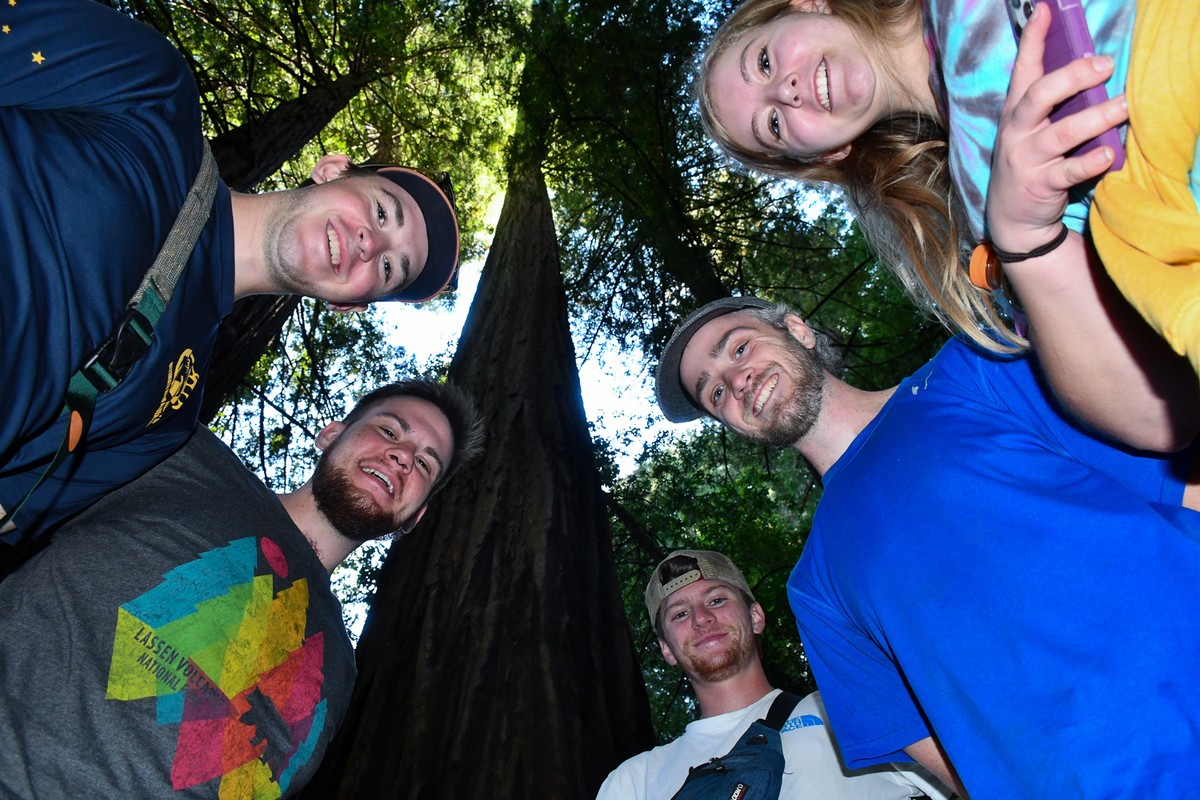
UC students pose in front of an enormous sequoia at Armstrong Redwoods. Pictured clockwise from top left are Samuel Hall, Kyleigh Hope, Cody Kessler, Kevin Kruse and Aaron Fletcher.
Seeing the world
Craig Dietsch, chairman of the Department of Geosciences, said the field trips often leave a lasting impression.
“We’ve had plenty of students go into unrelated careers. But they go on vacation and suddenly they find themselves looking at rocks in cuts in the road,” he said.
He has led more than 100 student field trips in his 33 years at UC.
“The weather is really important, oddly enough,” Dietsch said. “You can see the most fantastic rocks, but it doesn’t matter if it’s pouring rain or it’s cold or people are uncomfortable.”
UC's focus on experiential learning benefits students who want to learn outside the classroom. Through cooperative education or co-ops, students divide the year between classroom instruction and full-time employment in their chosen field. Meanwhile, UC offers plenty of room to explore through study abroad. Each year, students travel to more than 50 countries to broaden their perspectives and learn more about the world.
Firsthand learning
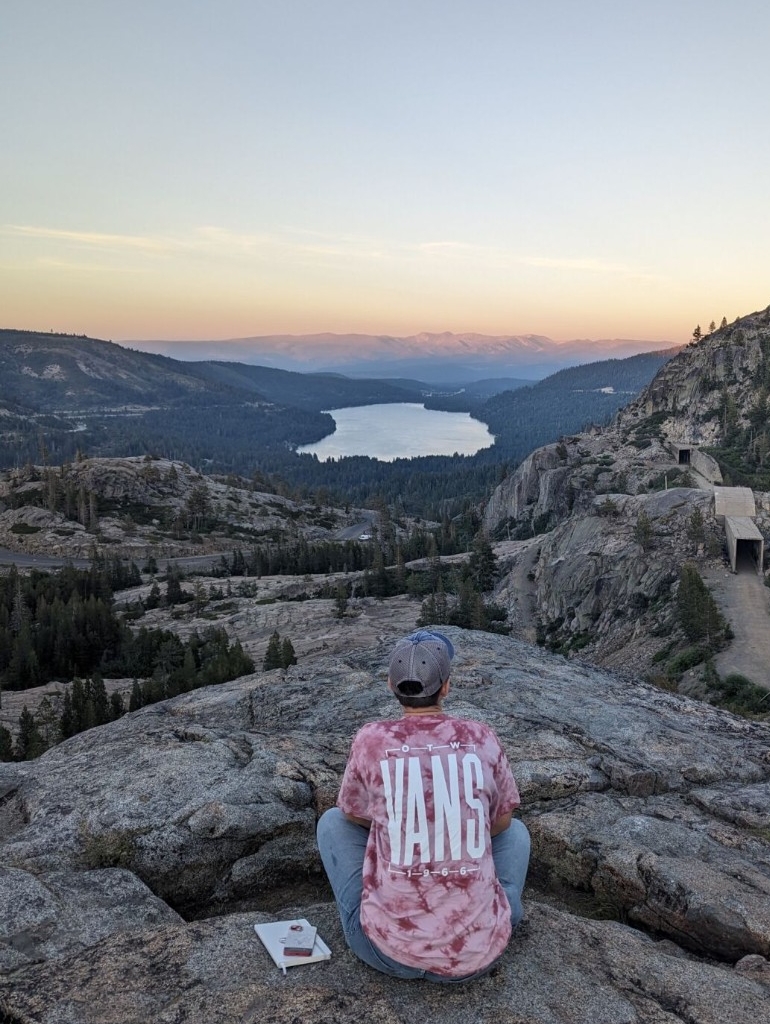
UC engineering student Casey Chapman enjoys the spectacular view atop the Donner Pass, made famous by the doomed migrants who became snowbound in the Sierra Nevada in 1846. Photo/Aaron Fletcher
At each site they visited, students fanned out to examine geologic features. They used hammers to shatter big rocks and study the exposed surfaces using whistle-shaped hand lenses that dangled from cords around their necks.
Then they huddled together for a discussion about the significance of each site.
“What do we know about this outcrop?” Dietsch asked the students “It’s broken, it’s fractured, it’s beaten to hell. What does that tell us? It was deformed at low temperature and pressure.”
Some of the impromptu lectures under the blue California sky lasted for more than an hour, but the students remained engaged, answering questions and asking their own.
“The ones who come along tend to be motivated,” UC professor Ward said. “They’re really eager to get out and see this stuff firsthand.”
The large group in neon-yellow safety vests attracted some attention when they stopped to study exposed outcrops.
On a quiet road, a woman pulled up in a pickup truck to chat with Academic Director Krista Smilek, who explained what the geology students were examining.
“Good luck!” the woman offered before driving away. “There’s gold in them thar hills!”
New experiences
Most of the students had never been to California. Some like undergraduate Kyleigh Hope had never traveled west of Indiana.
Hope has always been interested in science. She remembers in kindergarten finding coral fossils in her back yard — evidence that the Midwest was the bottom of an ancient ocean 440 million years ago.
“A lot of it is finding new things,” she said. “So there’s a dopamine hit from holding this tangible reward, but also stopping to fathom just how old it is in the palm of your hand.”
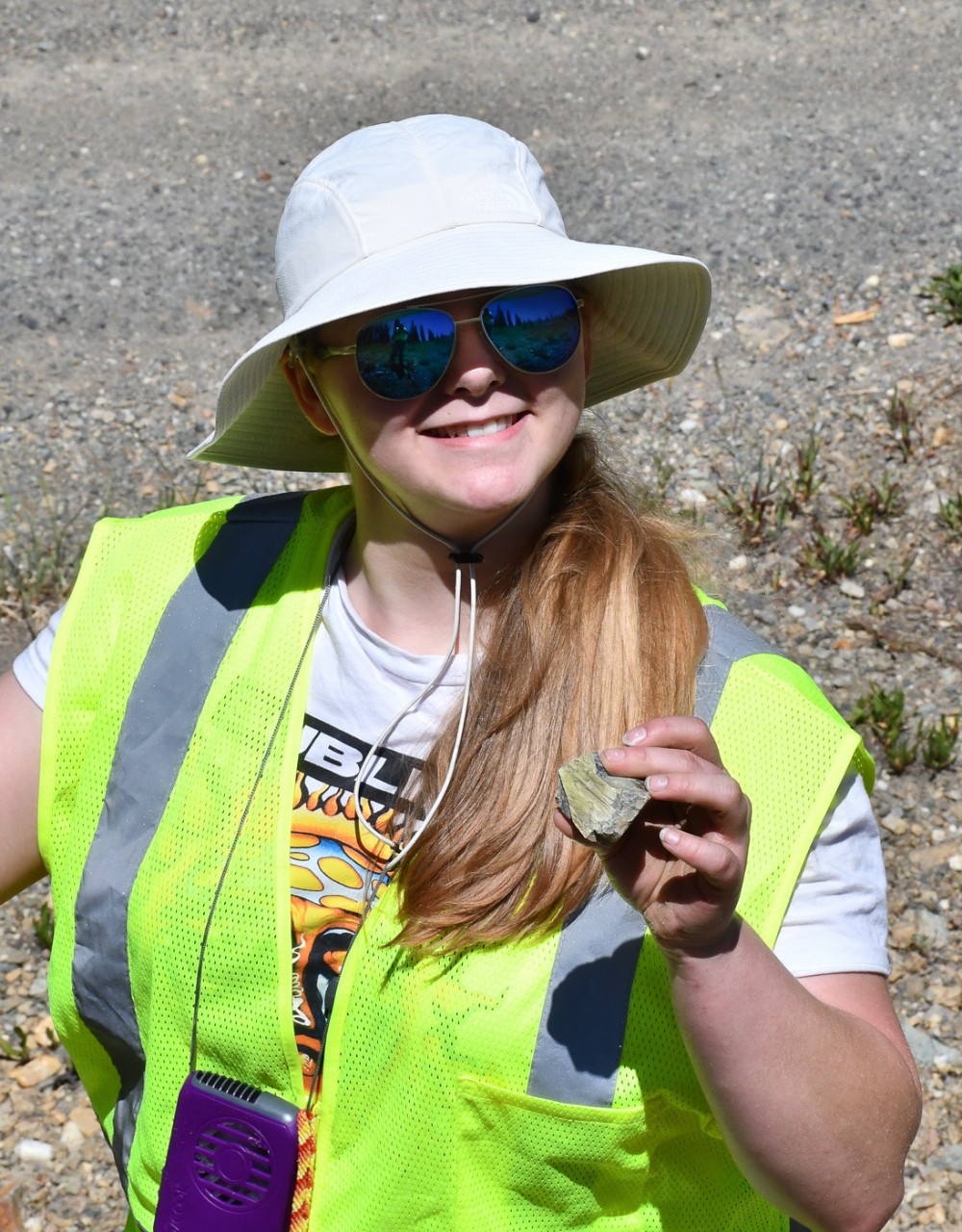
UC student Kyleigh Hope.
She loaded the music playlist for her group, playing an eclectic mix that spanned Twenty One Pilots, Panic! at the Disco, Ella Fitzgerald and AC/DC.
She was visibly delighted to identify ancient river sediment in a highway road cut. She had seen similar features on a geology trip to Illinois, she said.
“You see the pebbles embedded in the side of the hill and really distinct lines that show the degradation of sediments as the braided stream meanders through. It really jumps out at you,” she said.
And she appreciated that the tour featured women scholars such as Cal State Assistant Professor Tandis Bidgoli. While she isn’t sure where her career might take her, Hope said seeing other successful women in science gives her confidence that her future is bright.
“Geosciences is a male-dominated field,” Hope said. “But to see Tandis teaching these subjects, I know I can do it.”
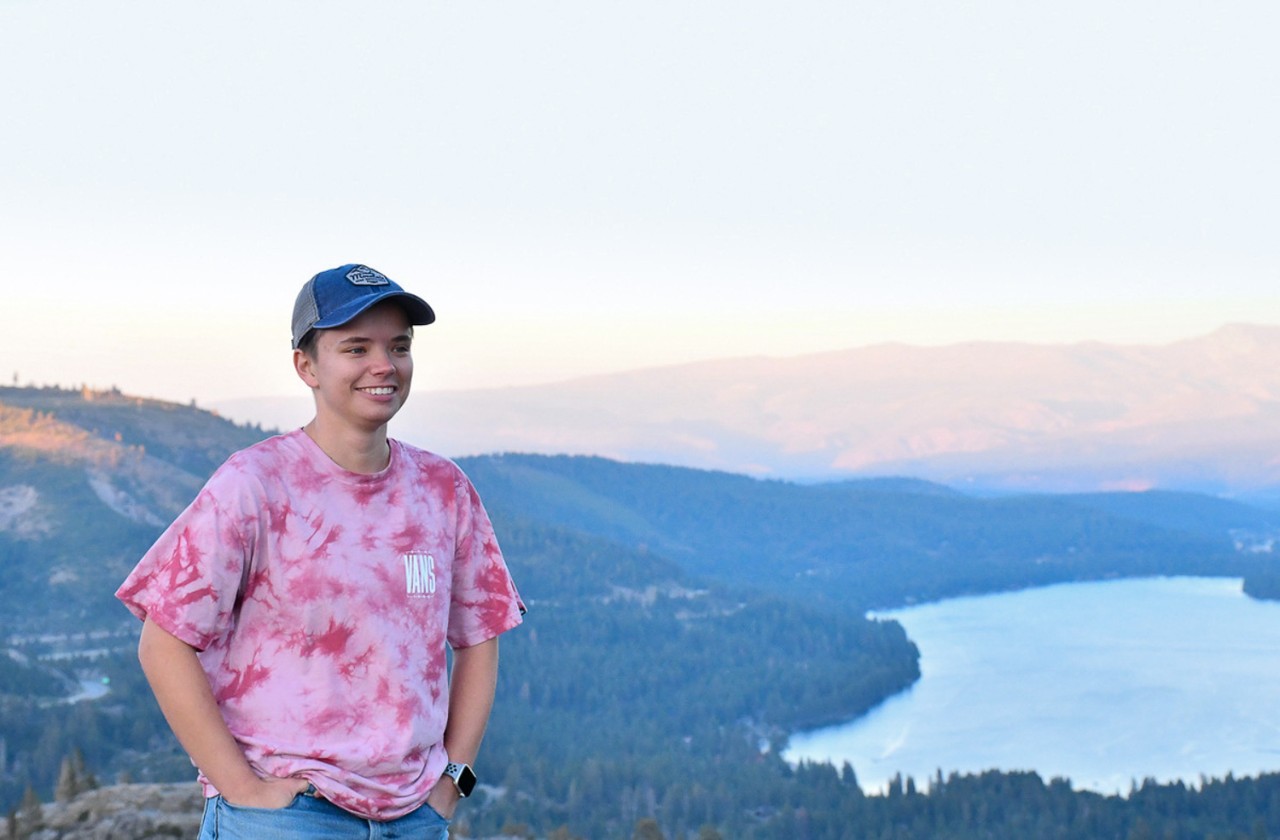
UC engineering student Casey Chapman stands on a cliff overlooking Donner Lake in the Sierra Nevada.

School of rocks
The 2022 geosciences field trip brought UC students, faculty and staff to northern Minnesota and Thunder Bay, Ontario, Canada, to study unique rock formations in the region along the north shore of Lake Superior.
History lessons
The caravan of vehicles climbed a mountain road to the top of the 7,000-foot-tall Donner Pass offering breathtaking views of its namesake lake. This route through the Sierra Nevada was made famous — or infamous — by the fateful 1846 migration by the Donner-Reed party. Trapped by heavy snow, the party resorted to cannibalism. But the students were there to stand on a glacier-polished granite cliff dating back to the age of the dinosaurs.
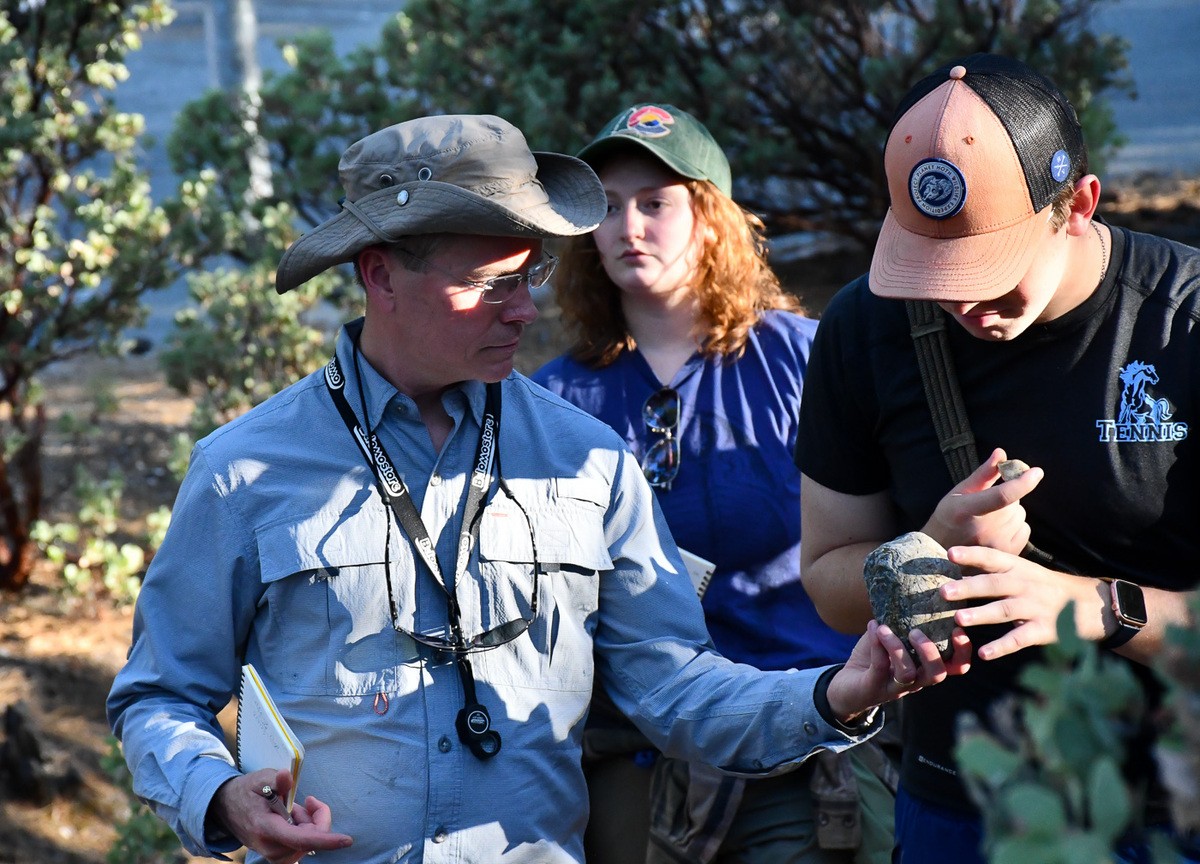
UC physics student Paul Smith, left, is working on a geophysics project in Nevada.
UC student Paul Smith spent 20 years in marketing at Cincinnati-based consumer goods giant Procter & Gamble Co. with a master’s degree in business administration before coming to UC to pursue a bachelor’s degree in physics. Today, he is a self-employed author and public speaker — and a junior in astrophysics.
Smith is working with professor Sturmer on a geophysics project, using gravimetric devices to record the relative gravity of suburbs around Reno, Nevada. These tools offer clues about the hidden geology of the earthquake-prone area as part of the U.S. Geological Survey’s National Earthquake Hazards Reduction Program.
Since he studies earthquakes, Smith said he was most excited about seeing evidence of California’s famed San Andreas Fault, the villain of 50 years of disaster movies in pop culture. A trail at the Point Reyes National Seashore features a fenceline, since rebuilt, that shifted 16 feet during a 1906 earthquake.
“I’ve been hearing about the San Andreas fault since I was a kid. You expect to see a crevice that goes down a mile, but that’s not at all what you see,” Smith said. “It’s a little anticlimactic.”
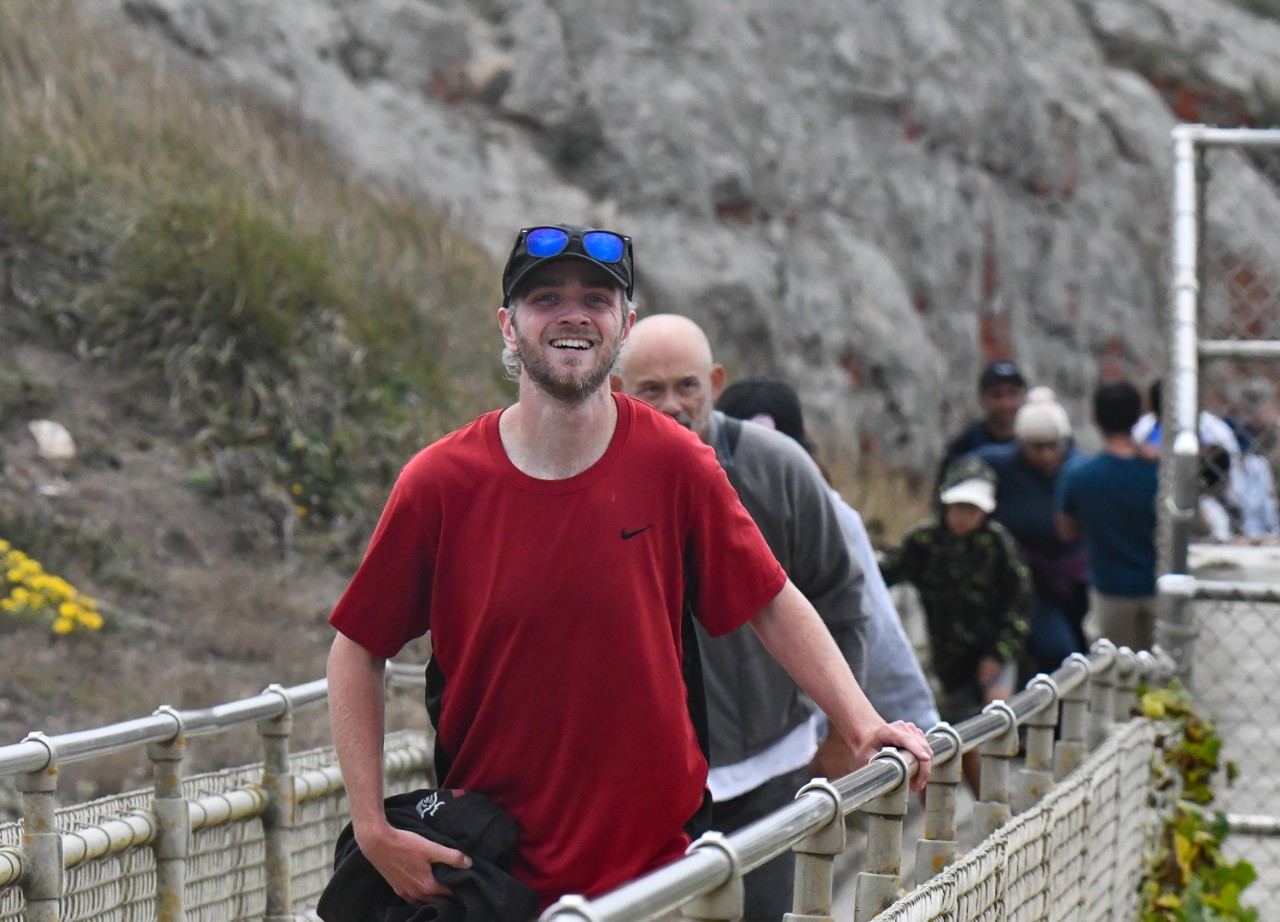
UC geosciences doctoral student Cody Kessler is all smiles after finishing a second lap of the 313 steps that lead down to the Point Reyes Lighthouse.
California dreamin'
At Lassen Volcanic National Park, students hiked a high-altitude trail to a geyser field full of boiling pools and mudpots. They stopped at mountain-sized lava domes known as the Chaos Crags that betray evidence of Lassen’s volcanic history, including an avalanche that hurled boulders more than 3 miles downhill where the students stood.
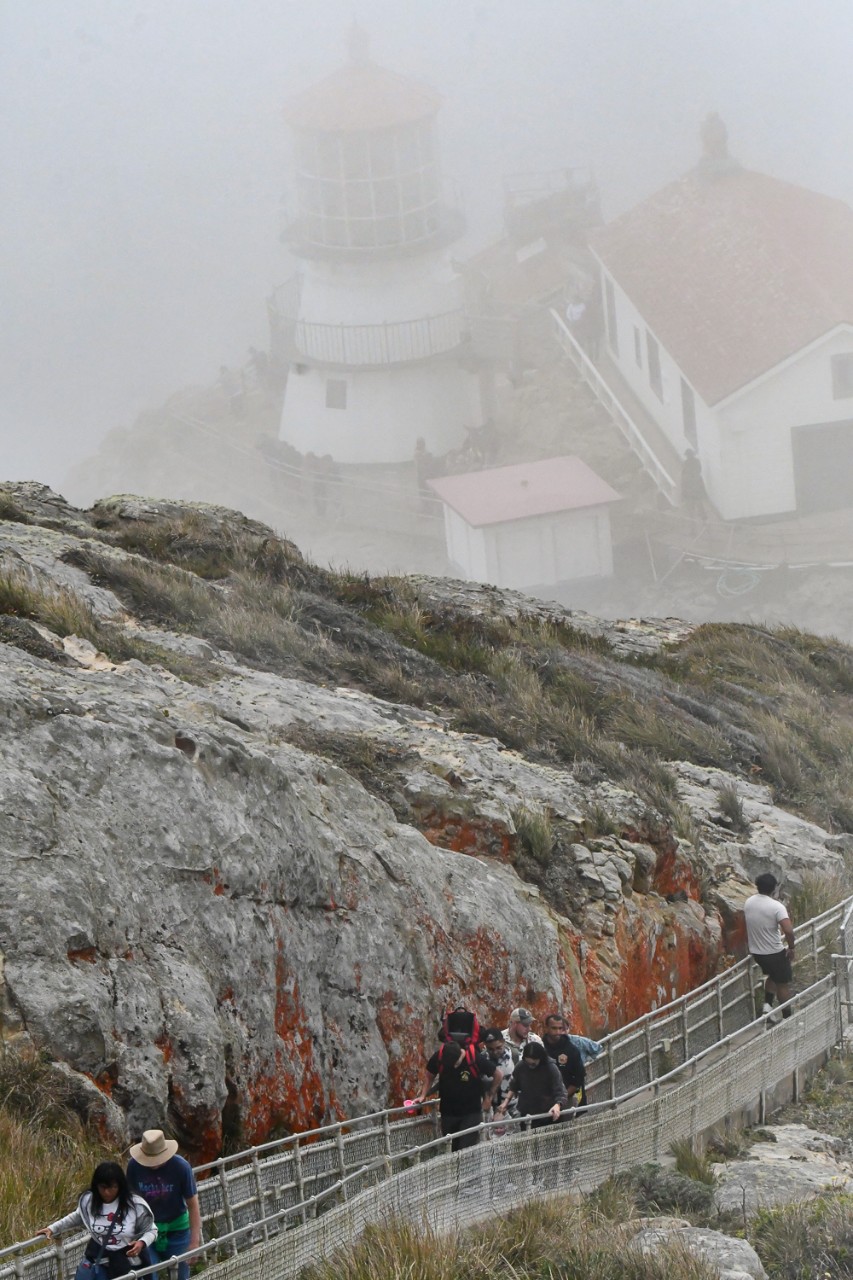
Students and faculty make the long climb up from the foggy Point Reyes Lighthouse.
They found evidence of California’s volcanic history at other stops on their route, including a road cut that exposed a wall of puffy black rocks that looked like burnt marshmallows.
“These pillow shapes and cross section is the classic undersea eruption of basaltic magma,” Dietsch said. “This is classic pillow basalt. So anytime you find pillow basalts, you know you have water, you’re on an ocean crust, you’re off the continental realm and in the oceanic realm.”
The students ended their journey at Point Reyes, where they spied coyotes, elk and mule deer in the sagebrush flats before reaching their destination, the historic 1870 lighthouse. The students hiked down the steep 313 steps to the lighthouse below to examine the surrounding conglomerate of sandstone, quartz and chert and then huffed and puffed back up the stairs.
Doctoral student Kessler ran the steps twice and even managed a smile when he got to the top the second time.
Fellow doctoral student Aaron Fletcher could only watch, incredulous.
“He would have gone a third time, but they were closing the steps for the night,” Fletcher said.
Budding careers
UC students who pursue careers in geoscience might have more opportunities than ever.
Demand for geoscientists is expected to grow by 5% in the next decade, according to federal projections. And jobs abound in fields as diverse as construction, hydrology, engineering and disaster mitigation, among others, said Sturmer, who teaches a fall class each year on careers in the geosciences.
“The traditional story of geosciences is going to Houston to work in energy. Those jobs still exist,” he said. “But there are all sorts of other opportunities, from environmental consulting to construction to finding the critical minerals we need for batteries and electronics.”
And many of the skills geosciences students learn such as data analysis are in high demand in completely unrelated fields, he said.
“Call me an optimist, but we’re in the golden age of geosciences because of the challenges of climate disruption,” Dietsch said.
Student Fletcher is working at the Metropolitan Sewer District of Greater Cincinnati as an environmental safety specialist while he finishes his dissertation in hydrogeology and geomorphology.
“Technically, I don’t do anything related to geology for my job, but it’s given me the skills and background to identify problems that arise and work with different equipment and programs,” he said.
He grew up on a farm in rural Ohio where he and his science teacher mom would hunt fossils.
As an undergraduate, he changed majors from English to environmental studies and hasn’t looked back. Now he is studying how human development is affecting both water quality and the dynamics of streams and groundwater in places like Cincinnati’s Cooper Creek.
“It used to be, ‘Ooh, a pretty rock!’” Fletcher said. “Now it’s, ‘Ooh, a pretty rock! What’s in it?’”
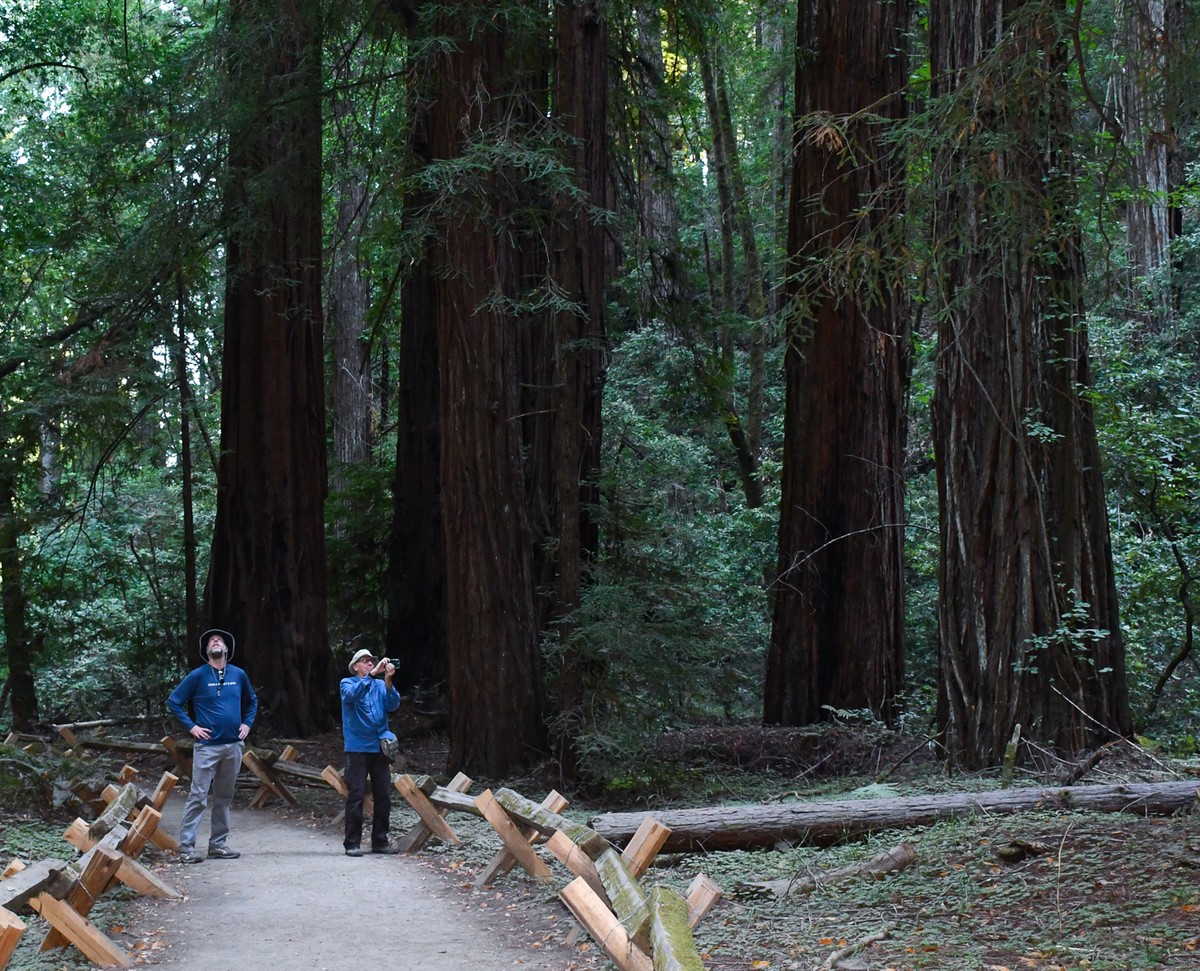
UC alumnus Brian Nicklen, left, and Craig Diestch, head of UC's Department of Geosciences, admire the towering sequoias of the Armstrong Redwoods.
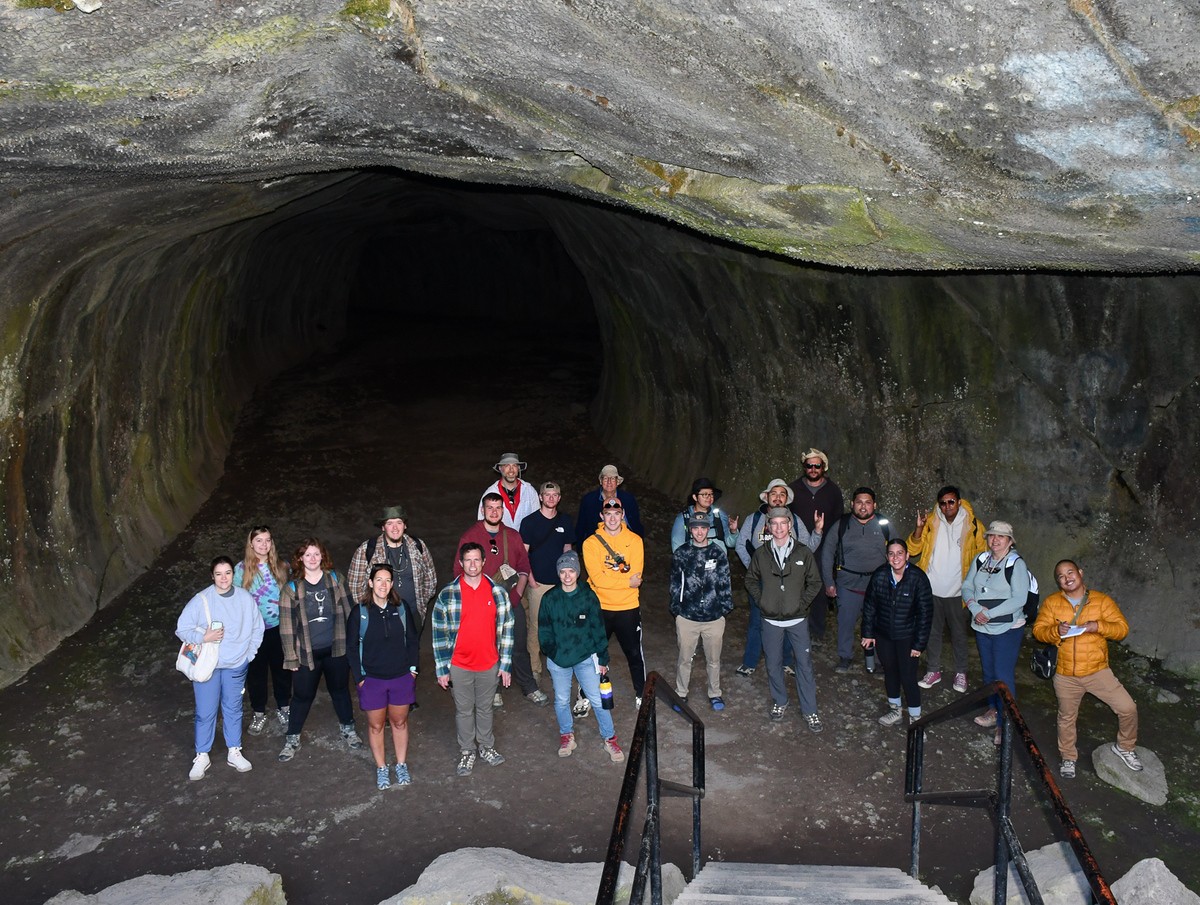
Students and faculty from the University of Cincinnati and the California State University, San Bernardino, pose in the mouth of Subway Cave, the remains of an ancient lava tube.
Additional credits
All photos/video: Michael Miller
Photo/video direction and editing: Andrew Higley
Digital design: Kerry Overstake
UC Marketing + Communications
Become a Bearcat
Whether you’re a first-generation student or from a family of Bearcats, UC is proud to support you at every step along your journey. We want to make sure you succeed — and feel right at home.
Related Stories
UC‘s College of Arts and Sciences taps innovative new leadership
December 20, 2023
The College of Arts and Sciences announced Ryan J. White and Rina Williams as the newest divisional deans of Natural Sciences and Social Sciences. White and Kennedy’s inclusion will bring new focuses and structure around student success and the college of Arts and Sciences’ advancement. Both will officially begin their new terms on Jan. 1, 2024.
What is UC’s 4 + 1 program?
December 4, 2023
You may be a UC student thinking about taking your education to the next level — UC’s College of Arts and Sciences has a pathway to help you do just that. A&S has no fewer than 15 five-year programs — from biological sciences to Spanish to psychology — where you can earn both your bachelor’s and master’s degrees in just five years, versus the traditional six-year track. The Bachelors and Master’s 4 + 1 Program is designed to increase your marketability and deepen your understanding of the subject matter. And in an increasingly competitive job market, you may want to investigate an additional year of study.
Clifton Court Hall grand opening garners detailed media coverage
September 20, 2023
The University of Cincinnati celebrated the opening of Clifton Court Hall on Tuesday, Sept. 19, with a ribbon cutting, attended by approximately 200 administrators, faculty, staff and students. The event was covered by multiple media outlets.
UC offers new social justice, Latin American studies degrees
October 7, 2020
University of Cincinnati students can now enroll to earn a Bachelor’s degree in two new humanities programs: Social Justice, and Latin American, Caribbean and Latinx Studies, offered through UC’s College of Arts and Sciences.
UC: Spice up your spring courses next semester
November 5, 2024
As students forge ahead through the fall semester, Open Enrollment season quickly approaches. New and continuing students at the University of Cincinnati are able to login to Catalyst and enroll in spring semester courses beginning on November 25. The College of Arts & Sciences offers a wide range of unique courses that can help students fill a few extra credit hours while having fun in a memorable class.
UC to celebrate grand opening of Clifton Court Hall
Event: September 19, 2023 3:00 PM
The University of Cincinnati on Sept. 19 will celebrate the grand opening of Clifton Court Hall, the biggest classroom building on UC’s Uptown campus.

